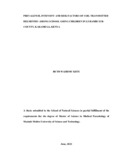PREVALENCE, INTENSITY AND RISK FACTORS OF SOIL TRANSMITTED HELMINTHS AMONG SCHOOL GOING CHILDREN IN LURAMBI SUBCOUNTY, KAKAMEGA, KENYA
Abstract
Intestinal helminths cause diseases and death in low and middle-income countries. Pupils are among the individuals at high risk of contracting intestinal helminthiasis. The use of contaminated water and improper hygienic practices are drivers leading to the
high prevalence of these infections. The aim of this research was to establish the prevalence, intensity, and risk factors associated with STH among school-going children in Lurambi Sub-County, Kakamega, Kenya. A cross-sectional study was conducted from January to February 2020 for two consecutive days in six primary schools among 384 randomly selected pupils aged 5 to 14 years. Risk factors associated with soil transmitted helminths were obtained by administering a structured questionnaire to the parents. Fresh Stool samples were gathered, processed and examined using the standard quantitative Kato-Katz technique. The data were entered and analyzed using SPSS version 20 and Epi Info version 7. 2. 3. 1. Descriptive statistics were performed to obtain the prevalence and infection intensity of the observed intestinal helminths. Multivariate logistic regression was performed to
determine the potential risk factors linked to intestinal helminthiasis. A confidence interval of 95% and a p-value of ≤ 0.05 were used. The general prevalence of helminthic infections was 14.4%. The prevalence of Ascaris lumbricoides was 11.5%,
Schistosoma mansoni 2.1%, Hookworm 0.4%, and Trichuris trichiura 0.4%. The STH accounted for 12.3% whereas S. mansoni accounted for 2.1% of the intestinal infection. Multiple infections of Hookworm and A. lumbricoides were observed (0.4%). Children aged 11-14 years who attended schools with rural set-up facilities accounted for a higher prevalence of S. mansoni. A. lumbricoides had the highest mean infection intensity of 3059 epg. Risk factors established in this study were; the behaviour of not washing hands before eating (OR=3.529; CI: 1.0539-11.8175; P= 0.041), consumption of unwashed fruits and vegetables (OR= 2.3129; CI: 1.831-4.1691; p= 0.005), the behaviour of not cleaning hands after handling soil (OR= 2.1529; CI: 0.9618-4.8189 p=0.005). Children who swam in rivers had odds of 3.3235 higher of contracting S. mansoni (OR=3.3235, CI: 0.359-30.7515). Age was also observed as a risk factor to S. mansoni (Z-statistic= 2.4006; P= 0.0164). This study found out that the prevalence of STH was low and that there was no heavy infection intensity observed. Integration of deworming with proper hygienic and sanitation practices should be done in order to eliminate intestinal helminthiasis in Lurambi Sub-County and at large in Kenya.

